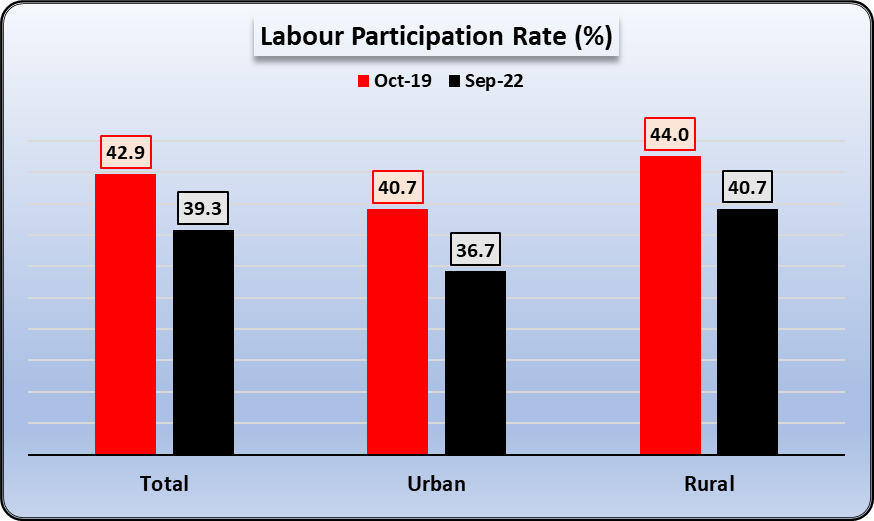Job Situation has Improved? Not so Fast!
The latest data on unemployment has been met with optimism, and near-celebration, especially in the mainstream media, which is straining at the leash to portray some good news about the economy under the Narendra Modi government. September’s unemployment rate fell to 6.43% from August’s 8.3%, according to the Centre for Monitoring Indian Economy (CMIE)—both in rural and urban areas.
While undoubtedly this is good news because the people, especially the youth, have been suffering tremendously from sustained unemployment over the past several years, if you look more carefully, there is little to show that this is the beginning of the long-forgotten ‘Achhe Din’. Let’s unpack the numbers.
Labour Participation Rate Falling
The number of people who are working (the employed) or seeking work (the unemployed) put together makes up the labour participation rate when taken as a share of the total working-age population. Usually, labour participation rates increase unless there is some economic crisis. That’s because it is likely that economies will create more jobs, giving more opportunities to people as time passes. After all, that is what a good government will do.
But see the chart below, drawn from CMIE, which compares the labour participation rate over the past three years—pre-pandemic (October 2019) and current (September 2022). Overall, the rate has dropped from nearly 43% to just more than 39%.

In urban areas, it dropped from nearly 41% to nearly 37% while in rural areas, it is down from 44% to just short of 41%.
Comparing October 2019 with now is a better way of evaluating the jobs situation because during the two pandemic years (2020 and 2021), the jobs crisis had intensified severely—joblessness had increased and labour participation had dropped. Therefore, comparing today to those years is not fair or sensible.
Remember that labour participation rate is made up of both employed people as well as the unemployed who are seeking jobs. It is possible that the unemployment rate may fall and yet the labour participation rate may still fall—it can happen if people get frustrated and simply stop looking for jobs. They will go from ‘unemployed’ to just ‘out of the labour market’. Therefore, just measuring the unemployment rate doesn’t give a full picture.
What does it mean for the labour participation rate to be lower now than three years ago? It means that there are limited job opportunities—maybe, even lesser than before. The number of employed persons in October 2019 was estimated at 40.41 crore while in September 2022 the number stood at 40.42 crore. That means, no significant jobs have been added in the past three years.
In urban areas, the situation is worse. In October 2019, there were 12.88 crore employed persons in cities and towns. This number declined to about 12.6 crore in September this year that’s an absolute drop of about 28 lakh persons. Despite the fact that the working-age population is constantly growing every year, the number of working people has actually dropped!
In rural areas, the number of employed persons was 27.54 crore in October 2019 which became 27.82 crore in September 2022. That’s an increase of about 28 lakh. In three years, this is all the growth that has taken place in employment in rural areas.
Low Wage, Insecure Jobs Haunt The Employed
Another dimension of the jobs crisis is that those who are being counted as ‘employed’ are mostly working at low wages, doing irregular work and with no job security. As pointed out earlier in Newsclick, wages or salaries range mostly between Rs 10,000 and Rs 15,000. Earlier studies have shown that a very large share of persons earn less than Rs 10,000. Real wages have, in fact, declined because of raging inflation.
How is this connected to unemployment? First, large-scale unemployment causes depression of wages because there are always people willing to work for ever lower wages. Desperation drives this acceptance of low wages and onerous work conditions. Secondly, lack of regular jobs forces people to do casual work who often juggle several ‘jobs’, which yield small earnings. It also forces people into ‘self-employment’, which often means retail trade (selling daily consumption items like vegetables, etc.), which is low paying and uncertain. Thirdly, low wages discourage many from taking up jobs altogether, resulting in the low labour participation rates mentioned earlier.
All this destroys the well-being and life of common people, although going by the data on company profits, the corporate sector seems to be enjoying a golden period of profits derived from low wage bills and high inflation.
The Centre appears to be content with making some periodic noises about this or that programme/project generating some airy-fairy number of jobs. But in reality, the Bharatiya Janata Party (BJP) government has spectacularly failed in keeping its most popular promise of creating jobs.
Get the latest reports & analysis with people's perspective on Protests, movements & deep analytical videos, discussions of the current affairs in your Telegram app. Subscribe to NewsClick's Telegram channel & get Real-Time updates on stories, as they get published on our website.
























